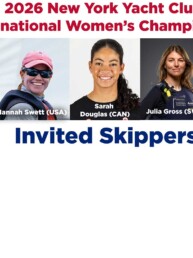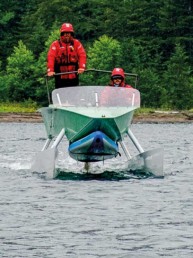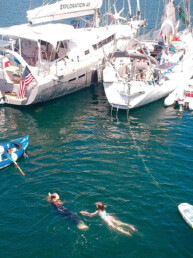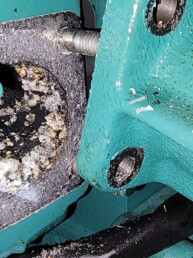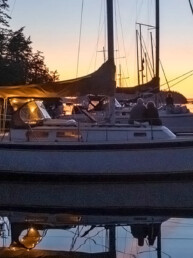“The least expensive and simplest way to foil on Puget Sound.”
When somebody like Dalton Bergan, one of Seattle’s most accomplished sailors, enthusiastically talks your ear off about a new watersport that has captivated him… you listen. Dalton is a great guy as well as a phenomenal sailor, and he’s always fun to talk with about things boat-related or otherwise. But I’ve never seen him like this. So what’s he so keen on? Wing foiling. And it seems to be exploding into the next big thing.
Wing foiling employs variations on concepts that will look familiar to anyone who has sailed, windsurfed, kiteboarded, or surfed. All of those pursuits now have people using hydrofoils to be lifted out of the water for reduced drag and higher speeds. Building on those predecessors, wing foiling is still in its infancy but strikes an appealing chord for its values of being relatively inexpensive, comparatively easy to learn, great for folks with limited time, and — crucial for the sunny season around Puget Sound — enormously fun in light-to-moderate breeze.
Wing foilers can now be seen in many locations around the Pacific Northwest, in increasing numbers every day. Like for kiting and windsurfing, the Columbia Gorge near Hood River is a world-class locale for wing foiling. Unlike those other sports though, which are typically reserved for only the windiest days on PNW waters, “wingers” are out on Lake Washington, Lake Union, even Green Lake; as well as many saltwater locations in Seattle, Edmonds, Everett, Anacortes, and beyond in a variety of conditions.
This seems like putting the conclusion before the argument, but I want to plant this seed for everything that follows. Going out wing foiling around Puget Sound seems pretty great on it’s own, but I’m already envisioning a dream scenario, and I haven’t even tried this sport yet. I see myself dropping a hook from a cruising sailboat in a San Juans anchorage after a pleasant sail. The hook holds, and after a little tidying up and a snack, the late afternoon thermal builds and fills the cove. I retrieve the foil board from where it is tied to the lifelines; then unpack the wing from its little backpack and pump it up. I wiggle into my wetsuit and drop into the chilly brine. I fly around the anchorage (or try to), perhaps dipping out into bigger water to catch a few wave rides for a lively and wildly fun hour, right up until it’s time for some sundowners and dinner. In terms of skills, equipment, and conditions, this fantasy is actually within reach for an enthusiastic beginner; and having a boat to launch from in exquisite Salish Sea surroundings makes it even more enticing.
What Equipment is Required?
There are three primary pieces of equipment, each of which involve some amount of variation and decision-making: the wing, the board, and the foil.
The wings are polyester sail material around an inflatable bladder structure, much like a kiteboarding kite. Different from the kite though, there’s a central strut in the bladder that divides the wing it two. On this central support are a series of handhold loops or, in some cases, a rigid bar to hold onto. Wings come in sizes ranging from 2 square meters to 7 square meters. Sensibly, bigger wings are better for lighter wind.
According to Dalton, the board can be almost anything, though more and more purpose-built boards are being made. His first attempts were on an old windsurf board that he retrofitted with a bit of fiberglass reinforcement where the foil attached. He thinks it would be possible to do this with stand-up paddleboards or surfboards too, and was even talking about making his own hollow board out of plywood and fiberglass to save weight. Most riders choose a pre-made foil board that is about 5 feet in length or a bit longer. The more important consideration is buoyancy. A more buoyant and stable board between 100-140 liters is likely to be better for a beginner, with more advanced riders potentially choosing smaller, lighter, and more nimble boards.
A mast extends underwater from an aft position on the board. At the end of that mast is the all-important foil… well, actually two of them. A larger primary foil extends just forward of the mast and provides lift with its downward-curving wing shape. A narrow fuselage runs aft from the foil behind the mast, and there’s a smaller foil on the trailing edge that provides stability. There are many variations in foil size and design, including nuance in aspect and chord length. Broadly speaking, larger foils are easier to learn on and better in light air. Smaller foils provide higher performance and greater maneuverability.
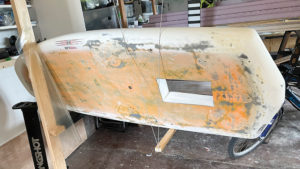 For anyone getting into the sport in the Puget Sound region, everyone I’ve spoken to encourages getting a large foil. Dalton told me, “Light wind and beginner boards and foils can be thought of as essentially one-and-the-same.” That seems particularly serendipitous around the Sound where, along with a larger wing, it is likely to be the most frequently used set-up anyway. As you advance and/or if you live in a windier area like the Gorge, it’s likely that you’ll want a smaller wing, and perhaps a smaller foil too, to get out there in rowdier conditions.
For anyone getting into the sport in the Puget Sound region, everyone I’ve spoken to encourages getting a large foil. Dalton told me, “Light wind and beginner boards and foils can be thought of as essentially one-and-the-same.” That seems particularly serendipitous around the Sound where, along with a larger wing, it is likely to be the most frequently used set-up anyway. As you advance and/or if you live in a windier area like the Gorge, it’s likely that you’ll want a smaller wing, and perhaps a smaller foil too, to get out there in rowdier conditions.
For all of the essential gear, which also includes leashes for wing and board, the likely range for a starter set-up is between $2,000-$4,000, and a bit less if you want to get creative retrofitting your board.
How It Works
A rider assumes a surf stance on the foil board (one foot forward, one back) and holds the wing handles with both hands, positioning it to catch the wind. The wing position is infinitely adjustable, but generally, it is easier to capture breeze downwind than upwind. The forward hand tends to hold the wing in a desirable position, while the back hand works more like a sheet on a sail, adjusting the angle for more or less power. Upwind wing position might look similar in orientation to a windsurfing sail, with one wing tip near (but not in) the water.
As the wing starts to draw the rider forward, water begins to pass over the underwater foil. Dalton estimates that only 5 or 6 knots of speed are required to get the foil working. With this speed, the foil will start to push the board and rider out of the water. As soon as you’re on the foil, speed will increase because drag is reduced — further increasing the efficiency of the foil.
One of the first skills riders must develop is a sense of fore-aft balance to adjust or maintain ride height on the foils. Foiling sailboats often have a mechanical device for ride height management (think of the wand on a Moth). With wing foiling, it is all body weight. Beginners will tend to lean back too much, fly too high, then crash. Developing a feel for how much weight to have on the front foot unlocks the fun in a major way.
Once flying on the foil and balanced, wingers can start to play with various points of sail and maneuvers. It is possible to tack and jibe and stay on the foil.
One skill that most wingers work to develop is an effective pumping motion. This is first and foremost done with the lower body and board. Anyone who has seen videos of foil surfers will be familiar with a movement like this. Pumping the board up and down with one’s legs helps pass more water over the foil, and can help either get up or stay up on the foil. When wing foiling, pumping the wing simultaneously may also provide a bit of extra lift.
I think this is important to clarify, and it’s something that Dalton and several other newer wing foilers emphasized. This really is wing-assisted foiling — meaning the focus and appeal centers around being up on the foil, and the wing is a tool to accomplish that goal. I was curious how much fun it would be just to play with a wing on a SUP — the answer seems to be some, but not nearly as much. For more advanced riders, especially in conditions where there are some waves, one of the goals is to hook into a wave, use your legs to pump the foil, let the wing fly behind you and just surf on the foil, carving the wave. The wing really isn’t necessary when surfing a wave, the foil and the power of the water are doing the work. Dalton said, “If it’s a windy day, what I’m really into is going out on the Sound near Golden Gardens, hooking into some wind swell, and just surfing. It’s really fun.” He told me he has been able to get some long surf rides similarly on boat wakes. With this in mind, I like to think that wing foiling begins as a sail-oriented sport; and as you progress, it might become more of a surf-oriented sport.
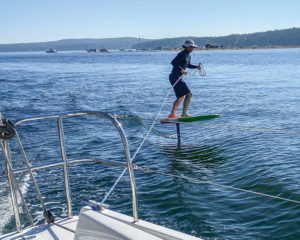 Learning To Wing Foil
Learning To Wing Foil
Dalton told me the story of how he first became aware of wing foiling. He was on vacation on Maui. He said, “I saw people foiling on incredibly small waves. The problem is that I can’t go surf real waves because I’m not paddle fit enough. It’s pretty hard to surf if you’re not doing it regularly. Even on 5-foot waves, you have to paddle out and paddle into the wave, and most people can’t just go do that. But here were these people surfing 2-foot waves and ripping. I thought, ‘Wow, I can do that.’”
Dalton began learning to wing foil Memorial Day 2020, so his tenure isn’t particularly long; but he has progressed rapidly, in part because he gets out frequently, even if it’s only for a brief ride. Considering the sport has only existed for a few years, he’s one of the area’s earliest adopters. Dalton doesn’t think he’s a very good case study for ease of learning because of his background with kiteboarding and foil kiting. Yet, he still wanted to emphasize that he thinks wing foiling is fairly accessible and easier to learn than similar alternatives. He says, “It is the least expensive and simplest way to foil on Puget Sound. And it isn’t easy, but it is great for someone up for the challenge of learning something new.”
When learning, it may be helpful to break the mechanics down into small bites. Some of the schools in other parts of the world that have started teaching wing foiling often recommend that your first day or two could be on a SUP, instead of a foil board, so you can learn how the wing works. Conversely, Dalton thought the more critical learning might be about balancing on the foil. For this, he noted that most cruising sailboats can tow you with enough speed (5-6 knots) to get you up on the foil and experimenting with weight placement, ride height, balance, and pumping.
I spoke to Andy Schmidt — an Edmonds-based sailor and friend of Dalton’s — who is just getting started in wing foiling, in part thanks to Dalton’s encouragement. Andy owns a 37-foot cruising sailboat and races Tasar and Aero dinghies. He also used to windsurf and tried a bit of kiteboarding, but emphasized that it had been many years since he even attempted either activity. He’s coming to the sport from a different vantage point than Dalton but, importantly, has also found his entry into wing foiling very smooth and enjoyable. Andy said a windsurfing background would mainly be helpful because of the prior knowledge of how to turn the board upwind or downwind. But he certainly didn’t think it was necessary.
Given that Andy is an experienced sailor, I wanted to know how sailing enters his brain when he’s trying to wing foil. He said, “It’s weird having the wing, because you’re sheeting in and out like a sailboat, but sometimes you bring the wing over your head to depower. So it’s different movements, but it becomes muscle memory pretty quickly, even as a beginner.”
Andy has only had his wing foiling set-up for a few weeks, and had been out five times when we spoke. He says, “On my third time on the water, I was foiling for short distances.” He found some “flat-ish water where it was blowing 12-15 knots,” and both he and Dalton described these as ideal conditions for learning. He described his first foil ride like this, “Once you get enough speed, you just lean back for a second and the board starts taking off like an airplane. Then you need to get your weight forward again.” He also stressed the learning curve with figuring out where your feet are on the board because “you want just a touch of weather heel, if you have too much the thing just turns upwind.” When you’re on the foil, you can adjust your feet but, for fore-aft movement, Andy is finding that just moving his hips a little bit is all it takes.
Andy lives near Richmond Beach and has been mainly going out in his local waters. And he hasn’t been alone. He told me, “There was also a woman with a stand-up paddleboard and a wing trying to learn. It’s a growing sport. My kids want a little wing to use with the SUP.” Andy has another friend who has been learning on Lake Washington and that’s where a lot of people are getting started. He’s also used his set-up off his cruising boat once, pumping the wing up on the bow and launching from the stern. He says, “it’s definitely coming with us cruising!” [Editor’s note, since the original publishing of this article, Andy went cruising and updated me. “The first great spot we found is American Camp on San Juan just after Cattle Pass. Wind from the Strait, but flat water.”]
Summing it up, Andy says, “It’s just another form of sailing, and is a lot of fun. It’s pretty neat when you get out of the water and all of a sudden it goes silent.”
Why are folks so excited about it?
One key to the sport’s appeal for the wingers I’ve spoken to has been the amount of enjoyment they get from a small amount of time on local waters. Andy told me that when he used to windsurf, “We would drive to the Gorge, which would take forever. We’d windsurf and have a blast, but it was so much driving time versus time on the water. This is something where you can go foiling in light wind near home.”
Dalton echoed this notion, and has been doing lots of sessions that last little more than a half-hour or 45 minutes. He says, “The hardest part is getting into your wetsuit.” He did a lot of learning on Green Lake, taking advantage of the flat water. Recently, he’s been launching from a beach near the Ballard Locks to take advantage of the current outflow to get up on the foil in even lighter wind. Foiling in such light conditions involves quite a bit of that pumping motion, so it’s good exercise — “you don’t have to go to the gym!” Vessel traffic coming out of the ship canal is part of the fun for that location too, and Dalton notes that he has foiled on boat wakes all the way from the mouth of the canal to West Point.
Another important draw is that this is a comparatively safe sport. Andy said he never got very into kiting, but was always intimidated by launching in potentially dangerous spots. With wing foiling, you can launch from shore with trees around without any worry. He noted that the board is fairly easy to paddle, and you’re not going to get stranded, which he said, “is a lot better than a kiteboard” or the sinker-style windsurf boards he used to ride.
While it’s still exhilarating, the speeds when wing foiling are lower than they would be kiting or windsurfing, and the wind capturing apparatus has significantly lower loads. As such, the crashes just aren’t as hard on the body. There is a small worry about landing on the foil when crashing, but both Andy and Dalton emphasized that this hasn’t been a problem for either of them and it’s quite easy to crash in such a way as to avoid the foil.
With its accessibility in all these ways, the sport is drawing in a lot of people in our region, and quick! Retailers around the world are having difficulty keeping wing foiling gear in stock. It is attracting all ages, and those with and without sailing, kiting, or surfing backgrounds; and might be a good option for those who have felt they had aged out of windsurfing or kiting. You can count me among the ranks of the fascinated, and I hope to give it a try soon — maybe even attempting to realize that dream of foiling around a San Juans anchorage. It is a safe bet that we’re all going to see a lot more wingers around the Pacific Northwest in years to come.
To tap into some of the regional enthusiasm, check out the Northwest Wing Foiling Group on Facebook. Title Background photo by Dan Kaseler.
Joe Cline
Joe Cline has been the Managing Editor of 48° North since 2014. From his career to his volunteer leadership in the marine industry, from racing sailboats large and small to his discovery of Pacific Northwest cruising —Joe is as sail-smitten as they come. Joe and his wife, Kaylin, have welcomed a couple of beautiful kiddos in the last few years, and he is enjoying fatherhood while still finding time to make a little music and even occasionally go sailing.

